This is not a complicated premise – hospital patients want information. They want to know who is taking care of them, what tests/therapies are scheduled, what are their restrictions – and they want the information in real time throughout their stay.
It seems obvious that the patient experience is vitally important to the patient. If you have been hospitalized, it is most likely not a happy stay. You are in an unfamiliar place with caretakers coming and going at all hours. You will be awakened to take medication to help you sleep. You’ll be whisked to treatments. Basically, you’ll be irritated throughout your admission. And probably not feeling so great, too.
The healthcare community is more aware of patient satisfaction now than at any other time – hospitals and personnel are evaluated by patients to document the satisfaction of the patient. Why is that important? There are metrics attached to high – and low – satisfaction ratings, imposed by insurers.
Data collected from a study and an audit shows that patient information delivered by devices containing E Ink Digital Paper results in higher satisfaction scores by patients when compared to static, analog means of information sharing.
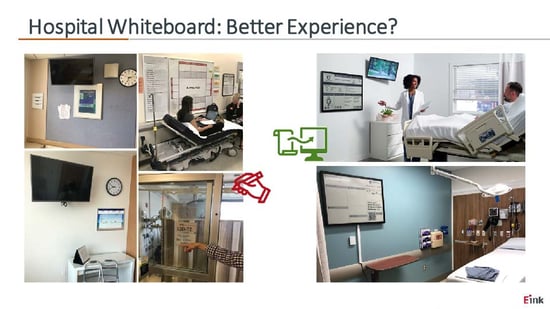
Study at Brigham and Women’s Hospital - funded by E Ink Holdings
This study was conducted by principal investigator Peter Chai, MD, MMS. The study compared standard whiteboards and digital paper whiteboards using E Ink modules. The study included the emergency department (ED) and iHub groups at Brigham and Women’s Hospital. The digital paper whiteboards were built by eVideon using E Ink Digital Paper. The study examined the environment of the ED – the uncertainty felt by the patient, the regular updates of status required, and the many distractions built into treating trauma in the ED.
Environment before digital paper whiteboards:
Verbal check-ins with staff and patients: conversations between providers and patients could be unreliable, and the lack of privacy increased exposure of sensitive information.
In EDs that provided patient apps, increased privacy and access to information was a plus for patients. On the downside, the patient needed a device and log in information. A phone or tablet could be misplaced.
Dry erase whiteboards are a low cost and durable means of sharing information. Unfortunately, they are rarely used in the high stress environment of the ED. As the information must be manually updated, they are prone to errors and can be exposed to everyone in the ED.
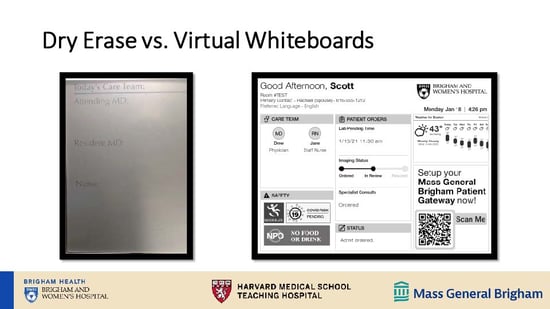
Study objectives
Two objectives were created:
-
Develop a patient facing virtual whiteboard screen interface that displays important hospital information and pertinent care team info in real time
-
Conduct a prospective cohort study to understand the effect of virtual whiteboard screens on patient satisfaction in the ED
Methods to collect patient satisfaction data
The parameters of the study included pre- and post-treatment surveys completed by the patients. The sample size was 100 participants. Four ED rooms were outfitted with virtual whiteboards.
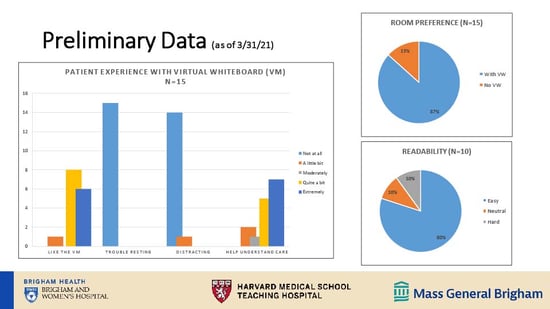
Preliminary data
- Early findings show that the following (insert graph with following results)
- Like the whiteboard – quite a bit
- Trouble resting – not at all
- Distracting – not at all
- Help understand care – Extremely
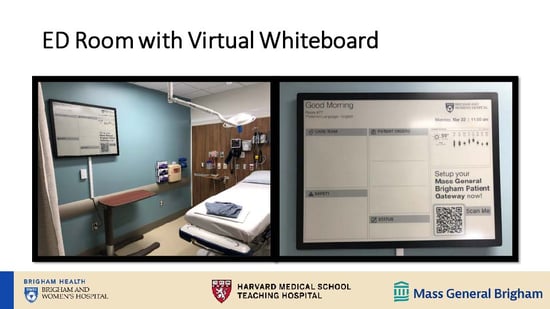
Texas Health Resources Audit
An audit by Texas Health Resources comparing patient satisfaction and the use of traditional whiteboards and digital whiteboards supported the prior concerns of traditional whiteboards - that information kept on the current analog whiteboards was inconsistent and inaccurate.
By standardizing patient-facing systems, and providing a centralized approach to deployment, we can ensure a consistent patient experience.
Premise – Digital care boards should ensure the following:
- Information accuracy
- Patient education
- Staff time savings
- Hospital costs
- Direct patient feedback
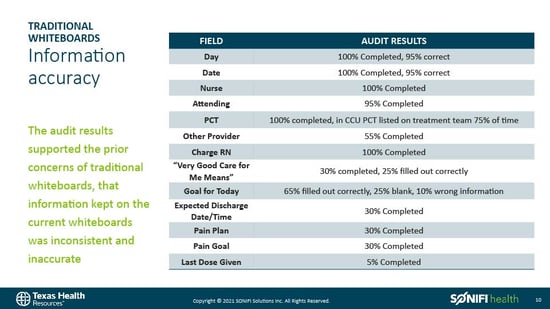
Lessons learned:
- Voice of the patient is key – one of the greatest influences and drivers
- Standardizing across the organization for the ITV platform
- Transition requires key stakeholder
Resources
Patient Satisfaction – Journal of Cutaneous and Aesthetic Surgery: https://www.ncbi.nlm.nih.gov/pmc/articles/PMC3047732/#:~:text=Patient%20satisfaction%20is%20an%20important,delivery%20of%20quality%20health%20care.&text=Patient%20satisfaction%20is%20an%20important,delivery%20of%20quality%20health%20care.
Video: Healthcare Innovation Product Showcase Day
https://youtu.be/1gNV_EEejQQ
Video: HIMSS TV Interview
https://himsstv.brightcovegallery.com/#/overlay/6217942898001
Webinar: Accurate Information is Vital: How Digital Paper is Optimizing the Digital Transformation Process (Nov-2020)
(Replay) http://go.eink.com/watch-our-webinar-replay-hcinnovations-accurate-info-is-vital
Webinar: How Digital paper can Enhance the Patient Experience (Apr-2020)
(Replay) http://go.eink.com/watch-our-webinar-replay-hospital-loaner-apr2020
Video: Introduction -Digital paper Solution for Healthcare
https://youtu.be/dcuE6DhCrf4
Webinar: The Missing Piece in Digital Healthcare Signage (Jun-2020)
(Replay) http://go.eink.com/watch-our-webinar-replay-22miles-missing-piece-0
Webinar: Accurate Information is Vital: How Digital Paper is Optimizing the Digital Transformation Process (Nov-2020)
(Replay) http://go.eink.com/watch-our-webinar-replay-hcinnovations-accurate-info-is-vital
Video: Healthcare Innovation Product Showcase Day
https://youtu.be/1gNV_EEejQQ
Webinar: eVideonand E Ink –Digital Paper Signage Solutions (Jun-2020)
(Replay) http://go.eink.com/watch-webinar-replay-evideon-eink-digital-paper-signage-solutions-0

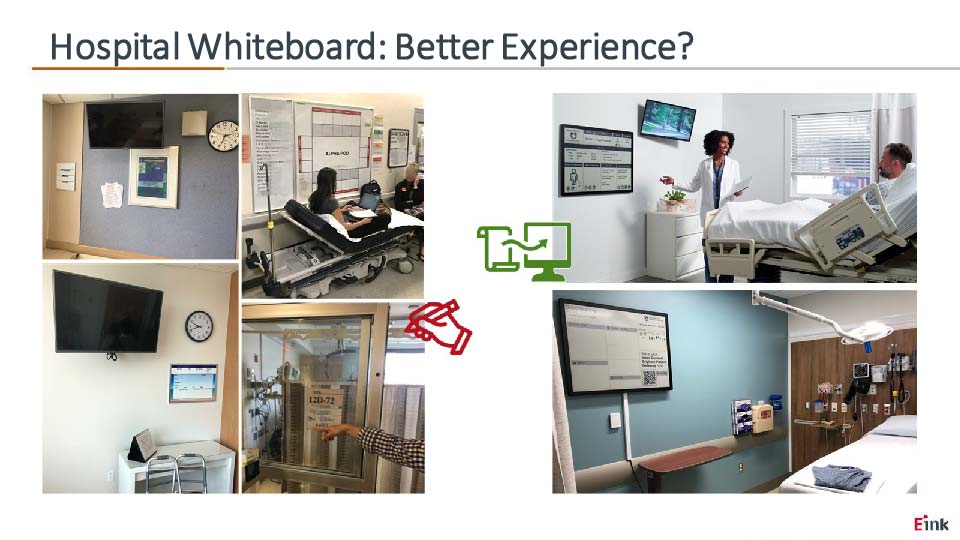
Leave Comment